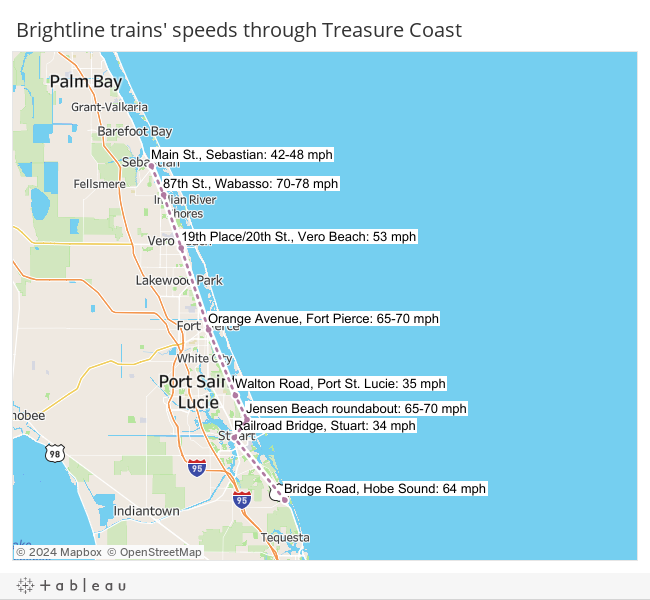Brightline trains: Here's how fast they really travel and how long they take to stop
How fast do Brightline trains really travel through the Treasure Coast?
TCPalm staff used a radar gun to clock the high-speed passenger trains at nearly two dozen locations — busy intersections and long straightaways — and found they ranged from 23-82 mph.
That's slower than Brightline has indicated.
Warning signs along the railroad tracks state trains "may exceed 80 mph" and Brightline has said trains will travel up to 110 mph between Cocoa and West Palm Beach and 125 mph between Cocoa and Orlando. Brightline also has said top speeds will be 110 mph through the Treasure Coast, but only 70-80 mph through its downtowns.
How fast are Brightline trains?
Brightline broke records as the fastest train in Florida and Southeast U.S. after test runs reached 130 mph between Cocoa and Orlando, the company announced in March.
Here are the miles per hour TCPalm found clocking trains over several days this month:
82: Monterey Road in Stuart
79: 20th Street in Vero Beach
78: 87th Street in Wabasso
70: Midway Road in Fort Pierce and roundabout in downtown Jensen Beach
69: Harbor Branch Oceanographic Institute in Fort Pierce
68: St. Lucie Village in Fort Pierce
64: Jonathan Dickinson State Park in Hobe Sound
63: St. Sebastian River railroad bridge in Roseland
58: 77th Street in Wabasso
53: American Icon Brewery in Vero Beach
51: Schumman Drive in Sebastian and County Road 707 in Rio
48-42: Main Street in Sebastian
45: Oslo Road in Vero Beach
44: Langford Park in Jensen Beach
40: Sebastian Center
38: Orange Avenue in Fort Pierce
35: Walton Road in Port St. Lucie
34: Stuart railroad bridge and Walton Road in Port St. Lucie
32: Confusion Corner in Stuart
31-23: 53rd Street in Gifford
Florida East Coast Railway trains can travel a maximum 60 mph, but TCPalm clocked four trains traveling between 14 mph and 51 mph.
How long do Brightline trains take to brake to a stop?
Each train is 550 feet long and weighs 643 tons, with two engines weighing a combined 140 tons flanking four passenger cars weighing a combined 503 tons.
Brightline says trains traveling at these speeds can take these distances to brake to a full stop:
110-125 mph: Over 1 mile
20 mph: 204 feet
30 mph: 376 feet
45 mph: 762 feet
60 mph: 1,195 feet
70 mph: 1,586 feet
80 mph: 1,960 feet
Railroad crossing safety precautions
Trains have the right of way over pedestrians, who are considered illegal trespassers on railroad tracks, as well as vehicles, including emergency vehicles such as police, fire and ambulances.
Federal Railroad Administration staff distributed safety pamphlets on the Treasure Coast on Sept. 22, the day Brightline began service between Orlando and Miami. Tips include:
At railroad crossings, slow down and approach with care.
Listen carefully for trains.
Look both ways, bending forward to see around obstructions.
Be aware of your surroundings and prepare to stop.
Do not enter a crossing unless you can drive completely through it without stopping.
Keep driving through the crossing even if the lights flash and the gates come down.
Leave at least 6 feet between your vehicle and the rails because trains are wider than the tracks.
Keep a cell phone on hand for emergencies.
If your vehicle stalls on the tracks:
Get out immediately.
Walk toward the oncoming train and move away from the tracks at a 45-degree angle. If a train hits your vehicle, the debris will move in the same direction as the train.
Call 911 or the emergency phone number posted on the blue signs at crossings.
For comments on this story, contact editor Cheryl Smith at cheryl.smith@tcpalm.com.
This article originally appeared on Treasure Coast Newspapers: Brightline train speeds through Treasure Coast and braking distances


